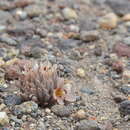en
names in breadcrumbs


Lenzia is a monotypic genus of flowering plants belonging to the family Montiaceae.[1] It only contains one known species, Lenzia chamaepitys Phil. [2]
Its native range is southern South America and it is found in Argentina and Chile.[2]
The genus name of Lenzia is in honour of Harald Othmar Lenz (1798–1870), a German teacher and naturalist in Thuringia and also historian of science, as well as a specialist in fungi and sponges.[3] The Latin specific epithet of chamaepitys refers the Ancient Greek words chamae meaning "ground hugging", and also pitys meaning "pine", from resemblance of the foliage to that of pine trees.[4] Both genus and species were first described and published in Linnaea Vol.33 on page 222 in 1864.[2]
Lenzia is a monotypic genus of flowering plants belonging to the family Montiaceae. It only contains one known species, Lenzia chamaepitys Phil.
Its native range is southern South America and it is found in Argentina and Chile.
The genus name of Lenzia is in honour of Harald Othmar Lenz (1798–1870), a German teacher and naturalist in Thuringia and also historian of science, as well as a specialist in fungi and sponges. The Latin specific epithet of chamaepitys refers the Ancient Greek words chamae meaning "ground hugging", and also pitys meaning "pine", from resemblance of the foliage to that of pine trees. Both genus and species were first described and published in Linnaea Vol.33 on page 222 in 1864.